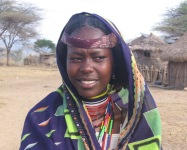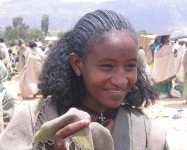Livlihoods
The Tigrigna and Amharic speaking people of the north are mainly agriculturalists, tilling the soil with ox-drawn plows and growing teff (a local millet). The most southerly of the Semitic speakers, the Gurage, are also formers and herders, but many are also crafts men. The Gurage grows, “false banana” whose root, stem and leaf stocks provide a carbohydrate, which after length preparation, can be made into porridge of unleavened bread. The Cushitic Oromo formerly nomadic pastoralists are now mainly engaged in agriculture and in the more arid areas, cattle breeding. The Somali, also pastoral nomads, forced to live in hot and arid bush country, while the Afar, semi-nomadic pastoralists & fishermen, are the only people who can survive in the hostile environment of the Danakil Depression. The people of the Omo are mainly nomads.
Hamer, Mursi, Karo, Geleb, Bume, Bena, Dasenech and others are nomadic pastoralists. They wander through their surrounding lands with knowing eyes and hands, carrying their few possessions spear, knives, and three-legged stool and driving their livestock before them, always forward to fresh pastures.
Clothing Styles
The people of Ethiopia wear many different types
of clothing. Highlanders use heavy cloth capes and wraparound blankets to combat
the night chill. In the heart of the lowland plains, light cotton clothes are
all that is required by men and women alike. The traditional cloth of Christian
highland peasantry has traditionally been of white cotton cloth; men have worn
long, Jodhpur like trousers, a tight – fitting shirt and a Shamma (loose
wrap).
The Muslims of Harar, by contrast, wear very colorful dress, the
men in shortish trousers and a colored wrap and the women in fine dresses of red,
purple and black. The lowland Somali and Afar wear long, brightly colored cotton
warps and the Oromo and Bale people are to be seen in the bead decorated leather
garments. National dress is usually worm on festivals, when streets and meeting
places are transformed into a sea of white, as finely woven cotton dresses, wraps
decorated with colored woven borders, and suits are donned.
A distinctive
style of dress is found among the Oromo horsemen of the central highlands, who
on ceremonial days such as Meskel attire themselves in lions’, manes or
baboon-skin headdresses, and carrying hippo-hide spears and shields ride down
to the main city squares to participate in the parades.
The most obvious
identification of the different groups is in the jewelry, their hairstyles &
the embroidery of the dresses. Both Muslims and Christians wear jewelry in silver
and gold, often with amber or glass beds incorporated. Heavy brass, copper and
ivory bracelets and anklets are also worn.
The women of Amhara and Tigray
wear dozens of plaits (Sherubal), tightly braided to the head and billowing out
of the shoulders. The women of Harar part their hair in the middle and make a
bun behind each ear. Arsi women have fringes and short, bobbed hair. Bale girls
have the same, but cover it with a black head cloth, while young children often
have their heads shaved.
Clothing of the Omo people is simple and effective
a short wraparound toga, enhanced with iron rings and other craft jewelry. Hairstyles,
however, more elaborate in the extreme shaped and fashioned with razor sharp knives
and adorned with a skull – cap of red mud. Many of the men are further decorated
with tribal cicatrice scars, which denote their standing in the community as young
warrior or wise elders. The women walk bare breasted, wearing a simple short skirt
of lather, the hems elaborately decorated with metal works.
Hamer, Geleb,
Bume and Karo men form a ridge of plaited hair and clay to hold their feathered
headwear in place. Hamer women wear a distinctive headdress of beaten tin plates.
Body paintings using clay and locally available vegetable pigments on face, chest,
arms, legs, etc are also common. The Mursi and Surma’s women are well known
for the large clay or wooden discs-terra-cota that they wear inserted in silt
in their ears and lower lips.




